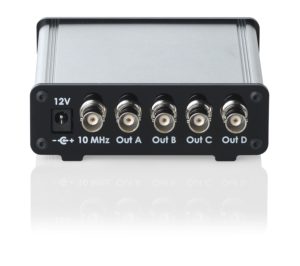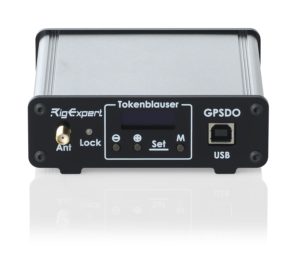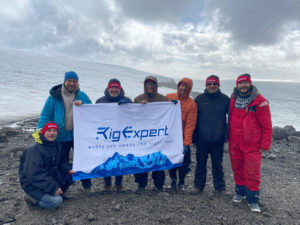Tokenblauser GPSDO: aсhieve perfect frequency coherence in every connection
Many amateur radio applications require special instruments and devices.
For instance, almost all kinds of UHF and microwave amateur communications require very highly stable synthesized local oscillators (LO).
This is important for any UHF and microwave bands, modes, and types of communications – terrestrial, satellite, meteor scatter, and EME.
• Terrestrial are random general QSO though Es, tropo, iono and other propagation mechanisms.
IARU R1 is organizing the annual UHF/Microwaves Contest in October and Microwave Subregional Contest in June where participants use the bands from 432 MHz to 122 GHz. The stable local oscillators (LO) are a must for successful operation and high contest scores on these bands
• Satellite communications are supervised by AMSAT.
It covers all kinds of satellites, Low Orbiting or LEO, and geostationary QO-100. The modes uses are voice, CW, and digital where frequency stability is vital. For LEO satellites the Doppler effect is an important factor as well.
• Meteor scatter communications are mainly used on 50, 70, and 144 MHz where the internal LO stability of modern transceivers is enough and does not require external high-stability oscillators.
• EME or Earth-Moon-Earth is the most demanding way to make QSOs on UHF and microwave bands. It requires a low-loss RF setup and extremely highly stable local oscillators. The Doppler effect is also an important factor. Only 13 amateurs worldwide worked 100 countries on 432 MHz and got a prestigious DXCC-70cm award.
How to achieve the very high stability of any UHF and microwave transmitting or receiving device.
The RigExpert Tokenblauser GPSDO is the perfect instrument for it.

For example, to use it in QO-100 ground station setup that uses the conventional LNB, the RigExpert Tokenblauser GPSDO signal source can be used after modified LNB for external LO frequency input.
By default, the Tokenblauser GPSDO “Profile:1” frequencies of A:24.0MHz, and B:25,0MHz are suitable for this.
The LNB output intermediate frequency (IF) for QO-100 of 739 MHz
This IF can be proceeded by several methods:
by applying it to the input of the modified SDR receiver whose frequency stability can also be increased by using the output D of the RigExpert Tokenblauser GPSDO signal of 28.8 MHz instead of the internal SDR crystal Local Oscillator. The proceeded data from SDR goes to the SDR CONSOLE V3 communications software.
by applying it to the input of the special 739 MHz to 432/144 MHz transverter and then to the antenna input connector of any VHF transceiver that has independent 144 and 432 MHz RF channels. This eliminates the need for the software and allows it to operate on SSB/CW directly using the transceiver alone. The frequency stability of the transverter and transceiver can be increased by using special devices like Rubidium standard or Tokenblauser GPSDO.
To transmit on 2.4 GHz one needs to have the appropriate up-conversion transmitting transverter and any HF or VHF transceiver with 28,144,432 or 1296 MHz bands. The transverter has to be fully lockable into an internal TCXO 10 Mhz reference or an external GPSDO and is best suited to be used with the RigExpert Tokenblauser GPSDO.
The external 10 Mhz from Tokenblauser GPSDO can be used with most modern transceivers and transverters having this option to achieve super high-frequency stability.
RigExpert Tokenblauser GPSDO use in DXPeditions.
Tokenblauser could become a useful tool for DXPeditions to remote places where Internet access is not available to synchronize computer time for reliable FT8/4 communication.
It is well known that WSJT modes FT4 and FT8 require precisely synchronized computer time.
This doesn’t happen automatically as in the case of 2023 Bouvet Island DXPedition.
Team Leader Kenneth Opskar LA7GIA writes: “We had issues with the FT8 due to we did not have any device to sync against, and our clock were 14 seconds off – which meant we at some time were TX odd, while we thought it was even.”
To synchronize computer time using RigExpert Tokenblauser GPSDO one has to make the following steps:
1. Get into GPSDO menu Prefs – Comm mode – GPS or use the trans command in the terminal mode.
This will enable to transmit data from the internal Tokenblauser GPS receiver into USB-port.
2.Install and run, as administrator, the Windows 7/10 GPS2Time software, choose the COM port and push “Run GPS” button. The computer time will be GPS-synchronized.
Discover more about Tokenblauser GPSDO at: https://reu.wiki/gpsdo.

